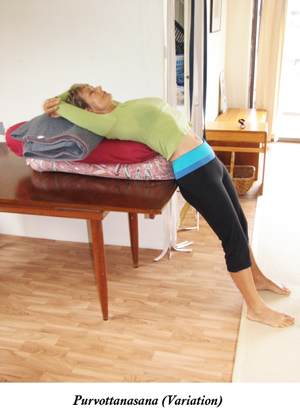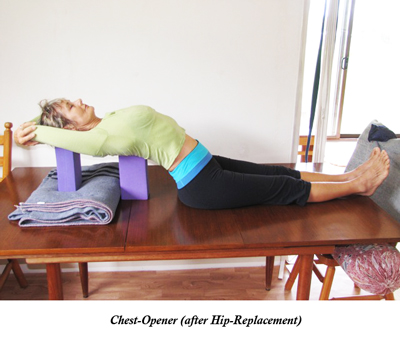
Posted by Live Yoga Life in Styles of Yoga on March 2nd, 2011
We have attended and enjoyed many Iyengar Yoga classes over several years. To someone who hasn’t tried Iyengar before it can seem a bit daunting. Not to worry – it is a very enjoy style of yoga that can provide amazing benefits if it matches what you need.
To help you get started we have outlined some things that you may find of use.
1. First cab off the rank – we would recommend finding a teacher in your local area who is certified by BKS Iyengar Yoga Association of Australia or Yogacharya BKS Iyengar. The reason for this is because teaching Iyengar Yoga is challenging. There is also the safety element – better teachers are safer teachers. Hence the quality of their teacher training is very high to ensure you are properly instructed in a safe environment.
2. Ask whether the teacher specialises in beginners. We have come to realise that some teachers are great with beginners, while other teachers are better with more experienced yogis. Basically – horses for courses.
3. Discuss with your chosen teacher any medical or fitness related issues they should know about. Your teacher should ask you if you have any medical problems or any other concerns before you start the class. However if the class is busy this can sometimes be shorter or may not happen. So we would recommend you discuss this when you first speak with the teacher about attending their class. It is also a great way to check out whether the teacher is right for you.
Women only: If you are menstruating it is advisable to inform your teacher. They may give you more appropriate postures during the class. Also it is highly recommended to advise your teacher if you are pregnant. Consult you doctor before starting any physical exercise like yoga. Also check with your teacher as to whether they are qualified to teach a pregnant woman.
4. Ask whether the studio runs a beginners course or something similar. This is often a great way to get into Iyengar Yoga as the instructions are aimed for beginners, and you can enjoy learning with classmates who are at your level.
5. Wear loose, comfortable clothing that allows you to stretch in. For example – shorts, t-shirt, track pants. Also it is recommended (and we wholehearted agreed from experience) that you shouldn’t eat 2-3 hours before hand.
These tips should assist you in finding the best class for you. We hope you thoroughly enjoy your Iyengar Yoga experience as much as we have.
Posted by Live Yoga Life in New Product Release, Updates on February 27th, 2011
Check out this new release – the complete set of 7 Iyengar Yoga Foundation Level Classes.
This program is an excellent foundation course on the fundamental yoga asanas (postures). Work on your posture , grounding and stability work in this static style of yoga. Enjoy exploring one pose at a time with attention to posture and correct alignment.
The Iyengar style of yoga is a static style that is known for it’s attention to anatomical alignment. It is also known for the use of props which not only allow muscle groups to release tension and tightness, but more importantly, it accommodates for differences in body types and structure.
Each class builds on the class before, adding extra poses and clear instructions.
Start off your yoga experience with thorough alignment and breath-work instructions. John Norris is a very experienced and certified Iyengar teacher well-known for his clear verbal instructions and his ability to bring students deeper in their asana practice.
We recommend that you repeat each class as many times as you need to before moving on to the next class.
In Iyengar yoga you will be using props / equipment – you need a yoga mat, a belt or strap, a bolster, a chair, 2-4 blankets, and wall-space.
Class 1: this class provides a gentle introduction to Iyengar yoga for any level of experience. Introduces you to the props and how to use them safely and effectively.
Class 2: builds on the foundation work in Class 1 – introducing new standing postures and seated twists, and giving more detailed alignment. This class provides a complete practice for the whole body.
Class 3: integrates the postures and alignment instructions from Classes 1 and 2. The focus pose in this sequence is Ardha Chandrasana (Half Moon Pose), a standing pose that works on your balance as well as opening the chest and shoulders. You are also introduced to the benefits of inversions by guiding you through an easy-to-do variation of Sarvangasana (Shoulder Stand), using the wall for support.
Class 4: integrates the poses from Classes 1 to 3, and introduces you to the basic movement in a Sun Salutation. The easy variation to Shoulder Stand is revisited and you are introduced to preparation work for other similar inversions.
Class 5: refines and integrates the standing and seated poses from Classes 1 to 4, continuing to build on the strength in your arms, legs, and core. In this sequence you are introduced to Hip-Openers to allow mobility, good stretches and flexibility around your hips.
Class 6: integrates the postures from classes 1 to 5, and introduces you to Utkatasana (Chair Pose) working on your legs and core, and Vrksasana (Tree Pose) a balancing pose. This class focuses on lengthening and releasing tension around the spine, and staying active yet relaxed in the poses.
Class 7: completes and integrates the foundation work you’ve done from Classes 1 to 6. By this point, you will be familiar not only with the fundamental poses and correct alignment, but also how these are referred to in Sanskrit, the ancient language in India.
Posted by Live Yoga Life in By Teachers, Yoga Therapy on March 10th, 2010
Written by Eve Grzybowski
Yoga Therapy, also referred to in the industry as “Remedial Yoga” or “Special Needs Yoga”, describes a specialised area of teaching or practice that offers a holistic approach to treating chronic or acute ailments.
What sort of treatment is offered?
A range of approaches are available – asanas (physical postures), breath work, relaxation techniques to reduce stress and release blocked energy, meditation, Ayurvedic (diet and lifestyle) remedies – some or all of these may be used for the purpose of creating or re-establishing balance in the body and harmony in the mind. Here below is an example of a propped yoga pose.

With consistent practice in the hands of a capable Yoga Therapist, one’s symptoms and even the causes of illnesses may be alleviated.
What is a Yoga Therapist?
A yoga therapist is usually a very experienced yoga teacher who, through years of teaching experience or consistent work with a range of different individuals of varying injuries and medical conditions, has developed the skills, and cultivated the knowledge and intuition to confidently work responsively with different conditions and body-types.
In consultation with the student, the Yoga Therapist designs appropriate practices for the student’s age, condition, and stage of life — in many ways providing the individual with a yoga prescription for special needs. The student can then practice this personalised sequence or set of sequences at home.
Ideally, the student will be inspired to keep up the consistent practice and maintain mental, emotional, physical and spiritual health as a way of life, on an ongoing basis.
The Yoga Therapist and student work together. The student is empowered by doing the yoga practice, and the Yoga Therapist assesses and refines the practice to create an optimum healing situation.
I can say personally that Yoga has assisted me therapeutically over the years dealing with symptoms of hip osteoarthritis. Yoga therapy practice also sped my successful recovery from major surgery after a total hysterectomy. Regular practice of yoga therapy routines assisted me to improve my body’s condition and general sense of well-being.
If you are looking for a practice to provide relief from hip arthritis or recuperation after hysterectomy (or other abdominal surgery), try out my Hip-Arthritis Routine and my Hysterectomy Routine available online here on LYL. These are both short, easy-to-do routines which I have specifically designed.

For yoga teachers – If you are interested in developing your skills in yoga therapy, you can train in Yoga Therapy in Australia. There are schools that run a courses offering a graduate certificate in the subject. You can also become a member of The Australian Association of Yoga Therapists, if you meet the organisation’s standards.
If you would like to participate in a Yoga Therapy Intensive, Byron Yoga Centre runs a 12-day course where I teach. This course is recognised by the U.S. Yoga Alliance.